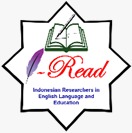Critical Discourse Analysis: English as It Is Learned and Treated in Asia
DOI:
https://doi.org/10.22219/englie.v4i1.24848Keywords:
Asia, critical discourse analysis, English language teaching, lingua francaAbstract
The English language teaching in Indonesia and some other ASEAN countries seem problematic. It can be seen from the low English proficiency of many school graduates despite years of learning English. Therefore, in the recent years, there has been a need of a new breakthrough in the English curriculum by considering local cultures and values so the English taught in schools is more contextual, practical and suits the local needs and usage. The curriculum is expected to reflect the English norms as a lingua franca in Asia, and not imposing native speakerism. This paper analyzes a newspaper article discussing how English is learned and treated in Asia, which was published in the Jakarta Globe, a popular local English newspaper. The analysis seeks further understanding on the discursive field of English, particularly in Asian context. Using Fairclough’s (2001) framework encompassing three stages (description - interpretation – explanation), this paper analyzes both macro and microstructure of the texts. The macrostructure is dealing with the ideology constructed in the texts, while the microstructure comprises the formal property or linguistic components. With these definitions, this critical discourse analysis (CDA) looks to find connections between microstructures of the text and the macro structures of social institutions and societies where the texts are distributed and consumed. From these three stages of critical discourse analysis, it was found that English is often portrayed as a prestigious language by using specific labels and metaphors. Besides, the ideology of “standard” and “monolithic view” of English is commonly imposed, and thus influences the English language teaching in Asia.
Downloads
References
Baker, W. (2015). Culture and identity through English as a lingua franca. In Culture and Identity through English as a Lingua Franca. De Gruyter Mouton.
Cogo, A. (2012). English as a lingua franca: Concepts, use, and implications. ELT journal, 66(1), 97-105.
Deterding, D. (2013). Misunderstandings in English as a lingua franca. In Misunderstandings in English as a Lingua Franca. De Gruyter Mouton.
Fairclough, N. (2001). Language and power. Harlow, Eng: Longman.
Hamid, M. O., & Nguyen, H. T. M. (2016). Globalization, English language policy, and teacher agency: Focus on Asia. International Education Journal: Comparative Perspectives, 15(1), 26-43.
Jenkins, J., & Leung, C. (2014). English as a lingua franca. The companion to language assessment, 4, 1607-1616.
Jenkins, J., & Leung, C. (2017). Assessing English as a lingua franca. Language testing and assessment, 7.
Kirkpatrick, A. (2002). ASEAN and Asian cultures and models: implications for the ELT curriculum and for teacher selection In A. Kirkpatrick (Ed.), Englishes in Asia (pp. 213-224). Melbourne: Language Australia.
Kirkpatrick, A. (2014). Teaching English in Asia in Non-Anglo Cultural Contexts: Principles of the ‘Lingua Franca Approach’. In: Marlina, R., Giri, R. (eds) The Pedagogy of English as an International Language. English Language Education, vol 1. Springer, Cham.
Kirkpatrick, A. (2014). English in Southeast Asia: Pedagogical and policy implications. World Englishes, 33(4), 426–438.
Le Ha, P. (2013). Issues surrounding English, the internationalization of higher education and national cultural identity in Asia: A focus on Japan. Critical Studies in Education, 54(2), 160-175.
McKay, S. L. (2002). Teaching English as an international language: rethinking goals and approaches. Oxford: Oxford University Press.
McKay, S. L. (2003). Toward an Appropriate EIL Pedagogy: Re-Examining Common ELT Assumptions. International Journal of Applied Linguistics, 13(1), 1-22.
Patil, Z. N. (2008). Rethinking the objectives of teaching English in Asia. Asian EFL Journal, 10(4), 227-240.
Walker, R. (2021). Teaching the pronunciation of English as a lingua franca. Oxford University Press.
Xu, Z. (2002). From TEFL to TEIL: changes in perceptions and practices: teaching English as an international language (EIL) in Chinese universities in P.R.China. In A. Kirkpatrick (Ed.), Englishes in Asia (pp. 225-244). Melbourne: Language Australia Ltd.
Downloads
Published
How to Cite
Issue
Section
License
Copyright (c) 2023 Eka Listianing Rahayu

This work is licensed under a Creative Commons Attribution-ShareAlike 4.0 International License.
Authors who publish with English Learning Innovation (englie) agree to the following terms:
- For all articles published in English Learning Innovation (englie), copyright is retained by the authors. Authors give permission to the publisher to announce the work with conditions. When the manuscript is accepted for publication, the authors agree to automatic transfer of the publishing right to the publisher.
- Authors retain copyright and grant the journal right of first publication with the work simultaneously licensed under a Creative Commons Attribution-ShareAlike 4.0 International License that allows others to share the work with an acknowledgement of the work's authorship and initial publication in this journal.
- Authors are able to enter into separate, additional contractual arrangements for the non-exclusive distribution of the journal's published version of the work (e.g., post it to an institutional repository or publish it in a book), with an acknowledgment of its initial publication in this journal.
- Authors are permitted and encouraged to post their work online (e.g., in institutional repositories or on their website) prior to and during the submission process, as it can lead to productive exchanges, as well as earlier and greater citation of published work (See The Effect of Open Access).
This work is licensed under a Creative Commons Attribution-ShareAlike 4.0 International License.
















1.png)












